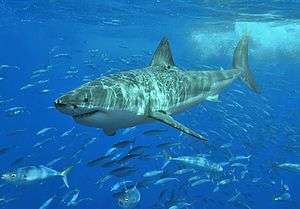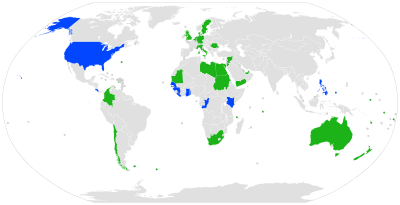Memorandum of Understanding on the Conservation of Migratory Sharks
 | |
| Signed | 1 March 2010 |
|---|---|
| Location | Manila, Philippines |
| Effective | 1 March 2010 |
| Signatories |
39
|
| Languages | English, French and Spanish |
The Memorandum of Understanding on the Conservation of Migratory Sharks is an international instrument for the conservation of migratory species of sharks. It was founded under the auspices of the Convention on the Conservation of Migratory Species of Wild Animals (CMS; also known as the Bonn Convention).
Background
Many sharks are apex predators and keystone species, meaning that they are at the top of their food chain and play a crucial role in maintaining the health of marine environments.[1] Sharks whose members cyclically and predictably move large distances are considered migratory and many pelagic (open ocean) shark species fall into this category. The IUCN considers one third of all shark species as threatened or near threatened.[2] For migratory sharks the situation is worse, with almost 50% being considered as threatened and 27% being considered as near threatened.[3] Relatively little is known about the behavior of migratory sharks; researchers have been surprised by data on their migrations.[4] Knowledge of 47% of sharks is too limited to determine a conservation status.[5]
Before the Migratory Shark MoU was developed, there were no international standards for the management of migratory sharks. Sharks that migrate can travel great distances in the world's oceans, with the whale shark being recorded on journeys of up to 13,000 kilometres (8,100 mi) long. These extensive migrations frequently and inevitably involve the crossing of national boundaries and through international waters; as the national regulations of coastal nations only apply to 200 nautical miles (370 km) of their coastlines, large parts of these journeys are consequently unregulated.[6]
The Migratory Shark MoU was the first global instrument published by the CMS,[7] and the first one ever regarding sharks.[8]
Objectives
The MoU is aimed at facilitating international coordination for the protection, conservation and management of the sharks involved, through multilateral, intergovernmental discussion and scientific research.[9] It is a global non-binding treaty aimed at improving "compliance and enforcement efforts" for states whose waters are inhabited by these sharks and to states whose flagships pass through international waters inhabited by these sharks.[9] Signatories to this treaty intend to expand information sharing.[10]
The memorandum states:[9]
"The objective of this Memorandum of Understanding is to achieve and maintain a favourable conservation status for migratory sharks based on the best available scientific information, taking into account the socio-economic and other values of these species for the people of the Signatory States."
Species

For the purpose of the MoU, sharks include all species in the class Chondrichthyes, which cover sharks, rays, skates and chimaeras. Currently there are 7 species listed in Annex I of the MoU, although the annex may be edited following consensus obtained at a meeting of the memorandum's signatories.[9]
Currently listed:[9]
- Great white shark (Carcharodon carcharias)
- Whale shark (Rhincodon typus)
- Basking shark (Cetorhinus maximus)
- Shortfin mako shark (Isurus oxyrinchus)
- Longfin mako shark (Isurus paucus)
- Porbeagle (Lamna nasus)
- Northern hemisphere populations of the Spiny dogfish (Squalus acanthias)
Signatories

The MoU is a legally non-binding agreement that currently has 38 Signatories, including the European Union.[11] About 40 national governments agreed to the original adoption of the MoU. Eleven of these signed it on 12 February 2010,[12] although only 10 were needed.[13] The MoU goes into immediate effect for signatories.[12]
This Memorandum of Understanding is open for signature by the Range States and regional economic integration organizations of the shark species listed in Annex 1 of this Memorandum of Understanding. Range States are defined as any State that exercises jurisdiction over any part of the range of migratory sharks, or a State, flag vessels of which are engaged outside its national jurisdictional limits in taking, or which have the potential to take, migratory sharks. As the CMS Sharks MOU was concluded as a legally non-binding agreement, a formal ratification process on the national level is not necessary.
The original signatories were Congo, Costa Rica, Ghana, Guinea, Kenya, Liberia, Palau, the Philippines, Senegal, Togo, and the United States. Nauru and Tuvalu signed on 9 September 2010. Australia signed on 4 February 2011. Sharks were already protected in Australian waters, but the government intends to work closely to distribute more information to other signatories.[10] Chile signed on 6 May 2011.[14] South Africa signed on 12 May 2011.[15] In November 2011, the European Union signed on to the MOU along with the European nations of Belgium, Denmark, Germany, Italy, Monaco, Netherlands, and Romania.[16] The United Kingdom signed in June 2012. Bermuda, the Falkland Islands, South Georgia and the South Sandwich Islands, the British Indian Ocean Territory, and the Isle of Man, all dependencies of the United Kingdom, also signed the agreement.[17] Vanuatu signed in February 2013.[16] In October 16, 2013, Colombia became the 27th country to the sign the Memorandum of Understanding on the Conservation of Migratory Sharks.[18] Sweden and Samoa signed the UNEP/CMS Sharks MOU respectively on 5 November 2014 in Quito and 7 November in Apia.[19]
Meetings
After two initial meetings in 2007 and 2008, the Memorandum of Understanding (MoU) was signed into effect on 1 March 2010, in the city of Manila, meeting the required amount of 10 signatures,[13] and taking effect immediately for each signatory. It has been adopted by over 40 states in total.[12] The original text is written in English, French, and Spanish,[9] and its creation was chaired by the Philippines.[12]
The First Meeting of Signatories to the Sharks MoU was held in Bonn, Germany, 24–27 September 2012. At the meeting, Signatory States adopted a new conservation plan, which aims to catalyze regional initiatives to reduce threats to migratory sharks. Signatory states also agreed to involve fishing industry representatives, NGOs, and scientists in implementing the conservation plan.
Meetings of Signatories are organized regularly to review the conservation status of the species and the implementation of the MoU and Action Plan. At the meetings there is also a possibility to sign the MoU.
Conservation Plan
A Conservation Plan has been adopted by the Signatories in 2012 whose implementation forms the basis of the ongoing work under the MOU. A favourable conservation status is achieved when the abundance and structure of populations of migratory sharks remains at levels adequate to maintain ecosystem integrity. The Conservation Plan, listed in Annex 3 of the MoU, is based on five objectives to achieve this goal:[20]
- Improving the understanding of migratory shark populations through research, monitoring and information exchange
- Ensuring that directed and non-directed fisheries for sharks are sustainable
- Ensuring to the extent practicable the protection of critical habitats and migratory corridors and critical life stages of sharks
- Increasing public awareness of threats to sharks and their habitats, and enhance public participation in conservation activities
- Enhancing national, regional and international cooperation
It requires the cooperation among governments, fishing industries, NGOs, local communities and scientists. An Advisory Committee has been established to provide expert advice and suggestions on new initiatives for the implementation of the plan.[11]
See also
References
- ↑ Griffin, E; Miller, K L; Feritas, B; Hirshfield, M (July 2008), Predators as Prey (PDF), Oceana, retrieved 1 March 2012
- ↑ "Third of open ocean sharks threatened with extinction". International Union for Conservation of Nature. 25 June 2009. Retrieved 1 March 2012.
- ↑ "Review of Migratory Chondrichthyan Fishes", CMS Technical Series No.15, 2007
- ↑ Daniel Cressey (7 May 2009), "Basking sharks run for the sun", Nature, doi:10.1038/news.2009.452
- ↑ UN wildlife conference enhances intergovernmental cooperation to safeguard sharks (press release), UN Environmental Programme, 12 February 2010
- ↑ Caitlin Howlett (16 February 2010), Migratory sharks need global protection: U.N., Cosmos Online
- ↑ "Convention on Migratory Species". Shark Specialist Group. Retrieved 1 March 2012.
- ↑ "Australia Signs CMS Shark Agreement". United Nations. 18 March 2011. Retrieved 1 March 2012.
- 1 2 3 4 5 6 "Memorandum of Understanding on the Conservation of Migratory Sharks – Official text"
- 1 2 "Memorandum of Understanding on the Conservation of Migratory Sharks – Fact Sheet". Environment.gov.au. Retrieved 1 March 2012.
- 1 2 CMS Sharks Team. "Memorandum of Understanding on the Conservation of Migratory Sharks". Retrieved 25 February 2013.
- 1 2 3 4 U.S. Department of State (19 February 2010). "Global Conservation of Migratory Sharks" (press release). Washington, DC. Retrieved 1 March 2012.
- 1 2 "Sharks". Convention on Migratory Species. Retrieved 1 March 2012.
- ↑ "Chile Becomes 15th Signatory to CMS Sharks MOU". International Institute for Sustainable Development. 6 May 2011. Retrieved 1 March 2012.
- ↑ "South Africa Signs Sharks MOU". Convention on Migratory Species. 12 May 2011. Retrieved 1 March 2012.
- 1 2 Summary Sheet: Memorandum of Understanding on the Conservation of Migratory Sharks (PDF), 1 December 2011
- ↑ "The UK takes another step to protect endangered sharks". Department for Environment Food and Rural Affairs. Retrieved 16 August 2012.
- ↑ "Colombia firma compromiso de protección de cuatro especies de tiburones". ElEspectador.com. Retrieved 16 October 2013.
- ↑ "New Signatories to the Migratory Sharks MOU" (PDF). CMS.int. Retrieved 28 November 2014.
- ↑ "Annex 3 to the MoU: CONSERVATION PLAN" (PDF). CMS Sharks Team.
